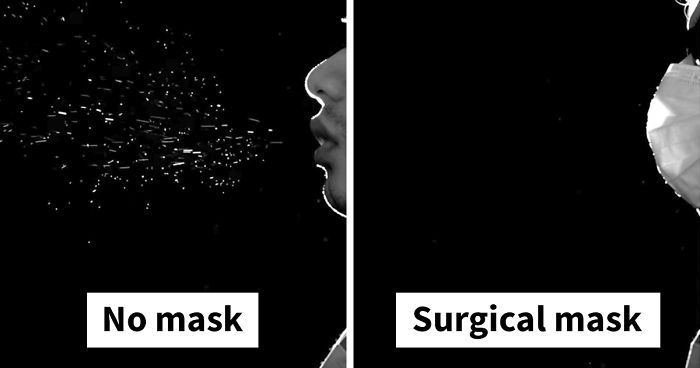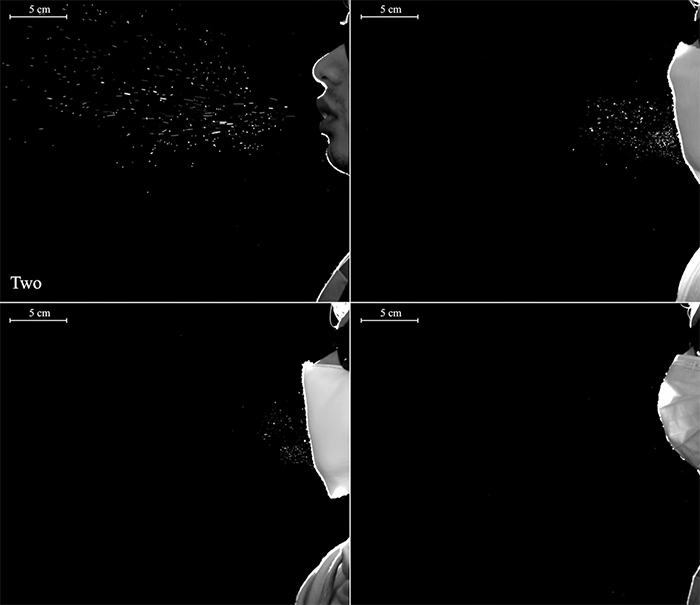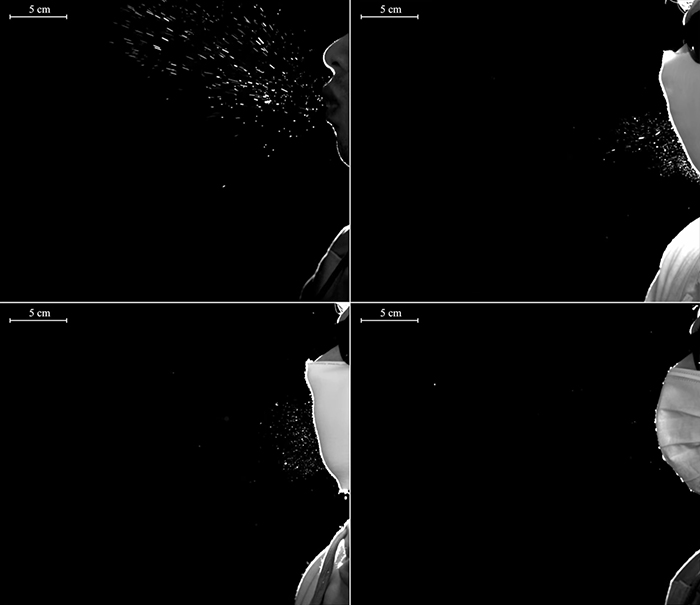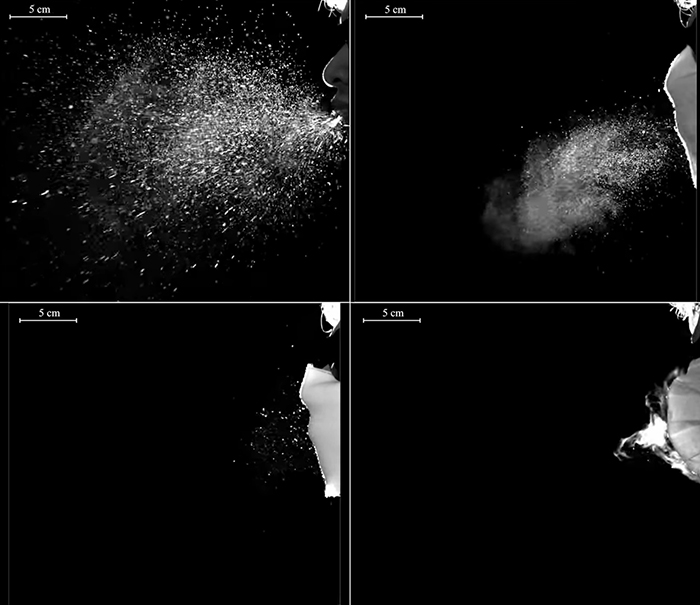
Video Shows How Masks Actually Work In Preventing The Spread Of Covid-19
While the debate on masks is still going on, the researchers at the University Of New South Wales used a LED lighting system and a high-speed camera to actually prove the effectiveness of different face coverings. “If you’re not sure whether wearing a face mask is worth it, or you need to wear a mask but are unsure which type, our new research should help you decide,” the scientists write. They took videos of people talking, coughing, and sneezing. In one scenario, the person was not wearing any mask; in two others, they wore two different types of cloth masks; and in the last one, the person wore a surgical mask.
More info: University Of New South Wales
The latest case study conducted by the University of New South Wales compares the effectiveness of face coverings
Image credits: UNSW
The conducted experiment revealed that a surgical mask was the most effective one at blocking droplets and aerosols when the person was either talking, coughing, or sneezing. However, the researchers say that if you can’t find yourself such a mask, “a cloth mask is the next best thing.” And apparently, the more layers there are, the better.
People were filmed talking, coughing, and sneezing while wearing different masks, or not wearing any at all
Image credits: UNSW
To film the case study, the researchers used a high-speed camera and LED lighting system which allowed them to visualize the droplets that we otherwise wouldn’t see. The experiment confirmed that speaking, too, does generate droplets. Naturally, coughing and sneezing produce even more of them.
The researchers concluded that to be on the safe side, it’s recommended to wear a mask with at least two layers of fabric
Image credits: UNSW
One of the things that the experiment also helped to see was that, while a single-layer cloth face covering can reduce the spread of droplets, it’s not as good as a two-layered one, let alone a surgical mask. Although researchers say that a 12-layered cloth mask is about as protective as a surgical mask, they “acknowledge it’s difficult to sew together 12 layers of fabric.” So here’s what they recommend: sew at least three layers together; use water-resistant fabric for the outer layer; choose a fabric with a tighter weave; and use hybrid (cotton–silk, cotton–chiffon, or cotton–flannel) fabrics as they provide better filtration.
Watch the video case study below
Image credits: UNSW
Here’s what people online said about it
35Kviews
Share on FacebookYep. But for pity's sake, please wash your cloth masks. Don't re-use disposable ones. And don't leave them dangling from your rear view mirror. A hot car is a nice incubator for germs of all kinds... Also, just ew! Yuck! Keep three reusable masks ---- wash, wear & spare!
Actually, University of Georgia did a study and found that a mask can be desinfected in a hot car (55C) in 20mins. This requires outside temp of 27C and a car in the sun for about an hour. If the temp in the car reaches 60C, it only takes 5mins to desinfect.
Load More Replies...I will never understand why people would refuse to do something that keeps themselves and others safe. I live in Texas, which is one of the hotspots, and it has gotten to the point that it is now required to wear a mask in most businesses and if you don't have one on when you come to the door, they will give you one. It is really simple:wear a mask and Covid might go away faster or keep fighting about it and it won't. Also on a side note: QUIT HAVING THE STUPID COVID PARTIES. If the test comes up positive then that means you have it, end of story.
People who read this and watch the video are likely NOT "problem children" who throw tantrums over mask wearing.
please, is any real study for masks that actually work In preventing the spread of so much B.S about covid 19, that really mean in old language like this explanation below, C mean see Ovid mean sheep and 19 is the number of surrender so, all together See the sheople surrender
No one wants to hear this! We want to know all the reasons not to wear a mask
Completely meaningless. LARGE particles from HEALTHY people are reduced when something is infront of the mouth, who would of thought (that's why they tell us to cough into our sleeve) U of M states many reasons why "masks for all" is pointless, along with real world studies. https://www.cidrap.umn.edu/news-perspective/2020/04/commentary-masks-all-covid-19-not-based-sound-data There is some agreement to their study, with a but: "There is evidence from laboratory studies with coughing infectious subjects that surgical masks are effective at preventing emission of large particles, and minimizing lateral dispersion of cough particles, but with simultaneous displacement of aerosol emission upward and downward from the mask." "In sum, wearing surgical masks in households appears to have very little impact on transmission of respiratory disease." Fear wins over all. And y'all are afraid, clutching at whatever you can to feel safe.
Yep. But for pity's sake, please wash your cloth masks. Don't re-use disposable ones. And don't leave them dangling from your rear view mirror. A hot car is a nice incubator for germs of all kinds... Also, just ew! Yuck! Keep three reusable masks ---- wash, wear & spare!
Actually, University of Georgia did a study and found that a mask can be desinfected in a hot car (55C) in 20mins. This requires outside temp of 27C and a car in the sun for about an hour. If the temp in the car reaches 60C, it only takes 5mins to desinfect.
Load More Replies...I will never understand why people would refuse to do something that keeps themselves and others safe. I live in Texas, which is one of the hotspots, and it has gotten to the point that it is now required to wear a mask in most businesses and if you don't have one on when you come to the door, they will give you one. It is really simple:wear a mask and Covid might go away faster or keep fighting about it and it won't. Also on a side note: QUIT HAVING THE STUPID COVID PARTIES. If the test comes up positive then that means you have it, end of story.
People who read this and watch the video are likely NOT "problem children" who throw tantrums over mask wearing.
please, is any real study for masks that actually work In preventing the spread of so much B.S about covid 19, that really mean in old language like this explanation below, C mean see Ovid mean sheep and 19 is the number of surrender so, all together See the sheople surrender
No one wants to hear this! We want to know all the reasons not to wear a mask
Completely meaningless. LARGE particles from HEALTHY people are reduced when something is infront of the mouth, who would of thought (that's why they tell us to cough into our sleeve) U of M states many reasons why "masks for all" is pointless, along with real world studies. https://www.cidrap.umn.edu/news-perspective/2020/04/commentary-masks-all-covid-19-not-based-sound-data There is some agreement to their study, with a but: "There is evidence from laboratory studies with coughing infectious subjects that surgical masks are effective at preventing emission of large particles, and minimizing lateral dispersion of cough particles, but with simultaneous displacement of aerosol emission upward and downward from the mask." "In sum, wearing surgical masks in households appears to have very little impact on transmission of respiratory disease." Fear wins over all. And y'all are afraid, clutching at whatever you can to feel safe.












90
20